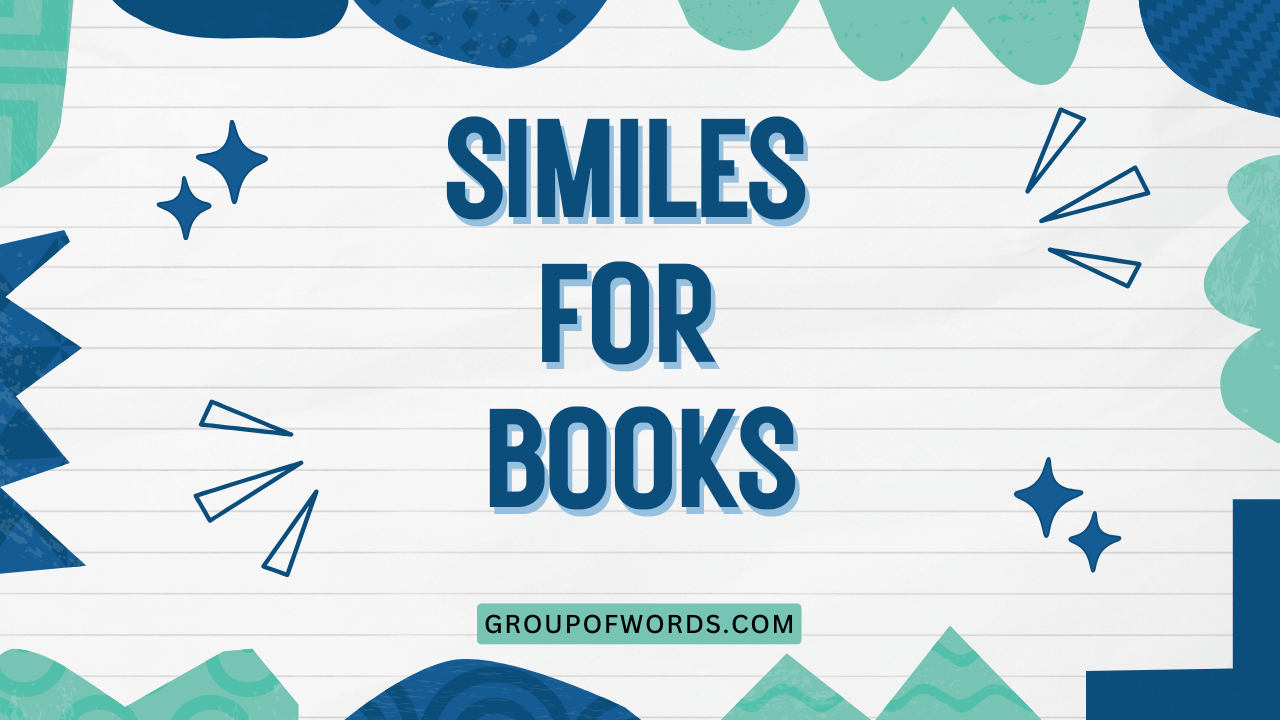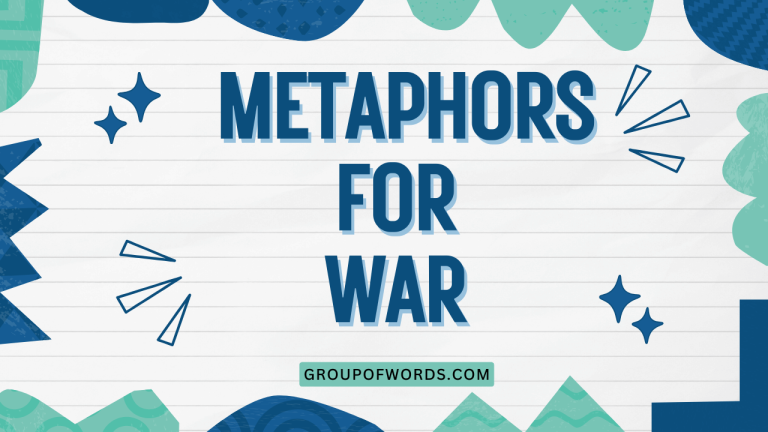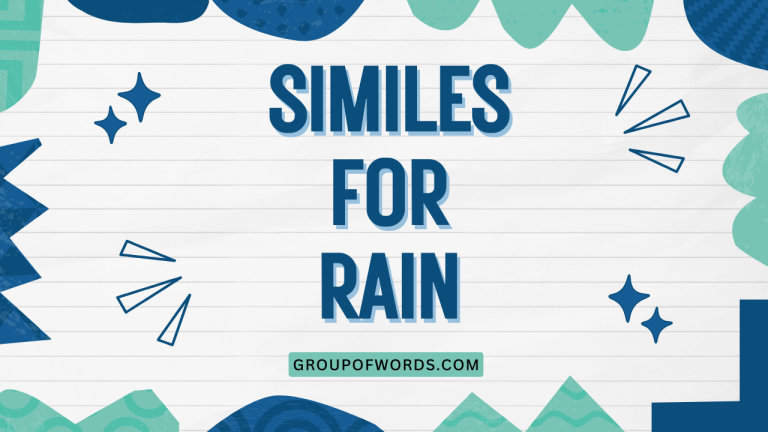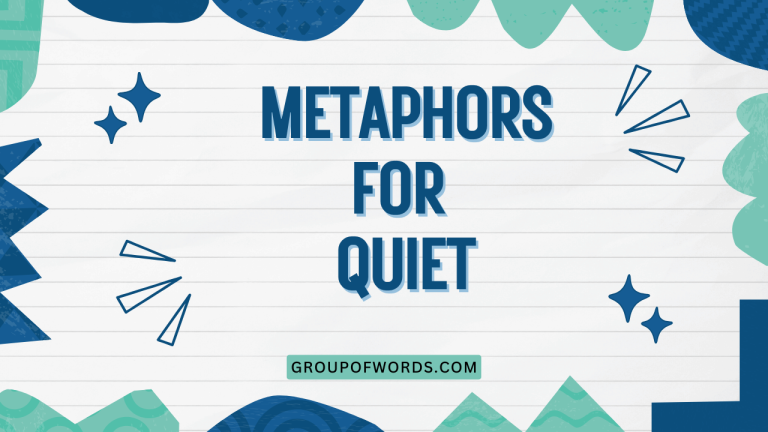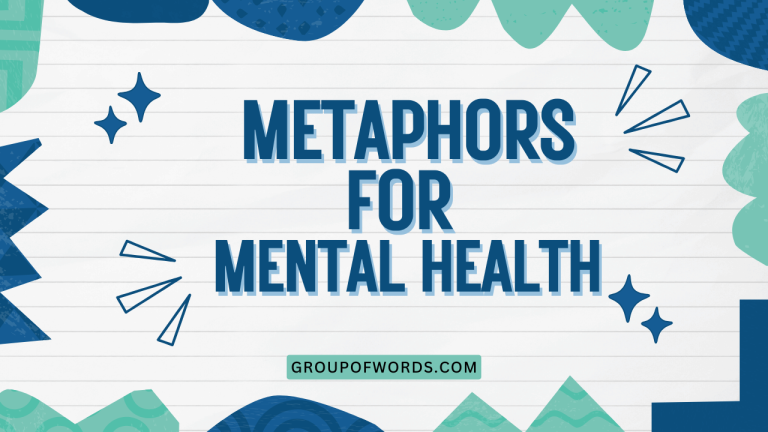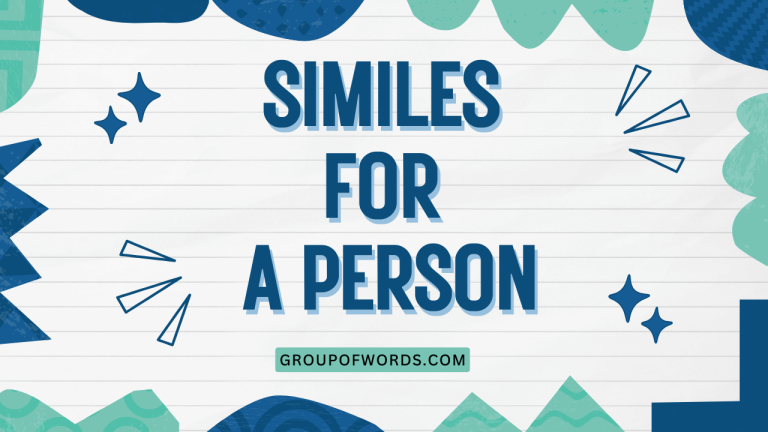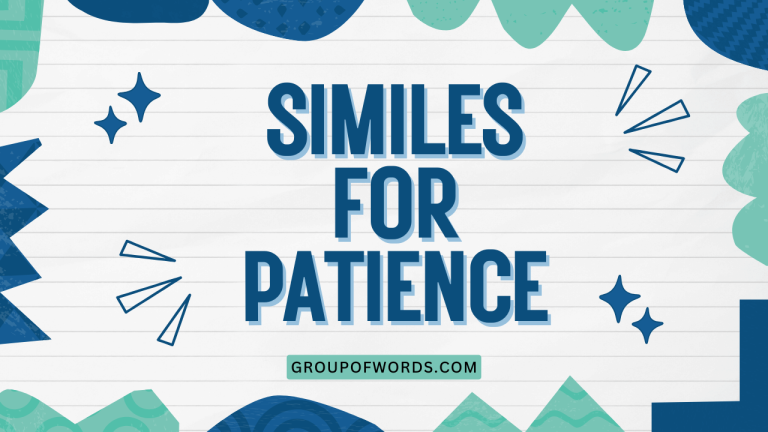Similes for Books: A Guide to Literary Comparisons
Similes are powerful tools in the English language that allow us to draw vivid comparisons between different things. When applied to literature, they can elevate writing from simple description to evocative imagery.
Understanding how to craft and recognize effective similes is crucial for both writers and readers. This article delves into the art of using similes to describe books, exploring various types, structures, and best practices to enhance your literary analysis and creative writing skills.
Whether you’re a student, writer, or simply a book lover, this comprehensive guide will equip you with the knowledge to appreciate and utilize similes effectively.
This article will cover everything from the basic definition of a simile to advanced techniques for crafting original and impactful comparisons. We’ll explore different categories of similes, analyze numerous examples, and provide practical exercises to solidify your understanding.
By the end of this guide, you’ll be able to identify, analyze, and create compelling similes that bring books to life.
Table of Contents
- Definition of a Simile
- Structural Breakdown of Similes
- Types of Similes
- Examples of Similes for Books
- Usage Rules for Similes
- Common Mistakes with Similes
- Practice Exercises
- Advanced Topics in Similes
- Frequently Asked Questions
- Conclusion
Definition of a Simile
A simile is a figure of speech that directly compares two different things using the words “like” or “as.” The purpose of a simile is to highlight a shared quality or characteristic between the two things being compared, creating a more vivid and understandable image or idea for the reader or listener. Similes are essential tools in descriptive writing and literary analysis, allowing for a deeper understanding and appreciation of the subject matter.
In essence, a simile is a bridge that connects an unfamiliar concept to a familiar one, allowing the audience to grasp the essence of the former through their understanding of the latter. This makes complex ideas more accessible and enhances the overall impact of the writing.
For example, saying “The book was long” is a simple statement of fact. However, saying “The book was as long as a Tolstoy novel” uses a simile to convey not only the length but also a sense of the book’s complexity and depth.
The comparison to Tolstoy immediately creates a richer understanding.
Structural Breakdown of Similes
The basic structure of a simile consists of three main components: the subject, the linking word (like or as), and the object of comparison. The subject is the item being described. The linking word establishes the comparison, and the object of comparison provides the basis for the comparison.
The structure can be represented as:
Subject + Linking Word (like/as) + Object of Comparison
Let’s break down an example:
“The plot was as twisted as a vine.”
- Subject: The plot
- Linking Word: as
- Object of Comparison: a vine
The effectiveness of a simile depends on the strength and relevance of the comparison. A strong simile draws a clear and insightful connection between the subject and the object of comparison, while a weak simile may be vague or irrelevant.
Furthermore, the order of the elements can sometimes be varied for stylistic effect, but the core components remain the same. For instance, “Like a rollercoaster, the book had many ups and downs” is a valid simile, even though the object of comparison comes first.
Types of Similes
Similes can be categorized based on the aspect of the book they are describing. Here are some common types:
Visual Similes
Visual similes describe the appearance of something related to the book, such as the cover, the setting, or a character’s physical features. They appeal to the reader’s sense of sight, creating a vivid mental image.
For example, “The cover of the book was as vibrant as a sunset” uses the visual imagery of a sunset to describe the cover’s color and intensity. Another example might be, “The protagonist’s eyes were like deep pools, reflecting years of untold stories,” which paints a picture of the character’s depth and experience.
Emotional Similes
Emotional similes convey the emotional impact of the book, describing how it made the reader feel. These similes tap into the reader’s emotions, creating a connection between the book and their own experiences.
For instance, “Reading the ending was like having my heart ripped out” vividly conveys the emotional pain the reader experienced. Another example could be, “The story was as comforting as a warm blanket on a cold night,” which suggests the book’s ability to provide solace and comfort.
Thematic Similes
Thematic similes relate to the central themes or ideas explored in the book. They help to highlight the underlying messages and concepts, making them more accessible and understandable.
For example, “The theme of redemption was as prevalent as the air we breathe” emphasizes the importance and pervasiveness of redemption in the story. Another example might be, “The book’s exploration of morality was like navigating a minefield,” which illustrates the complex and dangerous nature of the topic.
Character Similes
Character similes describe the traits, behaviors, or development of the characters in the book. They provide insight into the characters’ personalities and motivations, helping the reader to understand them better.
For instance, “The protagonist was as stubborn as a mule” reveals the character’s unyielding nature. Another example could be, “Her resilience was like a sturdy oak, weathering every storm,” which highlights the character’s strength and ability to persevere.
Examples of Similes for Books
Here are some examples of similes categorized by the aspect of the book they describe:
Similes for Plot
These similes focus on the structure and progression of the story.
The following table contains examples of similes used to describe the plot of a book. Each example aims to provide a vivid and relatable comparison to help readers understand the nature of the plot.
| Simile | Explanation |
|---|---|
| The plot twisted and turned like a mountain road. | Highlights the unpredictable nature of the plot. |
| The story unfolded as slowly as a flower blooming. | Emphasizes the gradual revelation of events. |
| The plot was as complex as a spider’s web. | Suggests intricate connections and deceptions. |
| The narrative flowed like a gentle stream. | Indicates a smooth and easy-to-follow storyline. |
| The plot was as predictable as the sunrise. | Implies a lack of surprises or originality. |
| The story was like a rollercoaster, full of ups and downs. | Conveys the excitement and emotional range of the plot. |
| The plot thickened like a pot of gravy left on the stove. | Implies a gradual increase in complexity and suspense. |
| The plot was as thin as a sheet of paper. | Suggests a lack of depth and substance in the storyline. |
| The story progressed like a chess game, with calculated moves. | Highlights the strategic and deliberate nature of the plot. |
| The plot was as tangled as a ball of yarn. | Implies confusion and difficulty in understanding the storyline. |
| The story was like a puzzle, with each piece slowly falling into place. | Conveys the sense of discovery and resolution as the plot unfolds. |
| The plot was as straightforward as a highway. | Indicates a clear and direct path through the storyline. |
| The narrative meandered like a river through the countryside. | Suggests a relaxed and unhurried pace in the storytelling. |
| The plot was as tightly wound as a spring. | Implies tension and anticipation building up in the storyline. |
| The story jumped around like popcorn in a hot pan. | Conveys a sense of chaos and unpredictability in the plot. |
| The plot was as circular as a labyrinth. | Implies a sense of being lost and going in circles within the storyline. |
| The story built up like a crescendo in music. | Highlights the increasing intensity and excitement in the plot. |
| The plot was as fragmented as a shattered mirror. | Suggests a broken or disjointed storyline. |
| The narrative unfolded like a map being revealed. | Conveys the gradual discovery of information and understanding. |
| The plot was as layered as an onion. | Implies depth and complexity with multiple levels of meaning. |
| The story moved at a snail’s pace. | Indicates a very slow and drawn-out plot. |
| The plot was like a runaway train. | Conveys a sense of unstoppable momentum and chaos. |
| The narrative was as refreshing as a cool breeze. | Suggests a pleasant and invigorating story. |
Similes for Characters
These similes focus on the personalities and attributes of the characters.
The following table provides examples of similes used to describe characters in a book. Each simile aims to create a clear and relatable image of the character’s personality or traits.
| Simile | Explanation |
|---|---|
| The protagonist was as brave as a lion. | Implies courage and fearlessness. |
| Her eyes were like stars, twinkling with intelligence. | Highlights her intelligence and brightness. |
| He was as cunning as a fox. | Suggests slyness and cleverness. |
| She was as gentle as a lamb. | Indicates kindness and innocence. |
| He was as stubborn as a mule. | Implies inflexibility and determination. |
| She was like a mother hen, protective and caring. | Conveys her nurturing and protective nature. |
| He was as cold as ice. | Suggests a lack of emotion and empathy. |
| She was as radiant as the sun. | Highlights her beauty and positivity. |
| He was as lost as a ship without a sail. | Implies a lack of direction and purpose. |
| She was like a chameleon, adapting to any situation. | Conveys her adaptability and resourcefulness. |
| He was as strong as an ox. | Suggests physical strength and endurance. |
| She was as graceful as a swan. | Highlights her elegance and poise. |
| He was as quiet as a mouse. | Implies shyness and unobtrusiveness. |
| She was as fierce as a tiger. | Conveys her aggression and determination. |
| He was as wise as an owl. | Suggests intelligence and knowledge. |
| She was like a willow tree, bending but never breaking. | Conveys her resilience and ability to withstand hardship. |
| He was as quick as a whip. | Implies speed and agility. |
| She was as delicate as a flower. | Highlights her fragility and beauty. |
| He was as steady as a rock. | Suggests reliability and stability. |
| She was like a storm, full of energy and chaos. | Conveys her intensity and unpredictable nature. |
| He was as mysterious as the night. | Implies intrigue and hidden depths. |
| She was as loyal as a dog. | Highlights her faithfulness and devotion. |
| He was as slippery as an eel. | Suggests elusiveness and untrustworthiness. |
| She was like a lighthouse, guiding others through darkness. | Conveys her role as a source of hope and direction. |
Similes for Themes
These similes illustrate the core ideas and messages of the book.
The following table contains examples of similes used to describe the themes of a book. Each example aims to provide a clear and impactful comparison to help readers grasp the underlying messages.
| Simile | Explanation |
|---|---|
| The theme of love was as bright as the sun. | Implies the central and illuminating nature of love. |
| The theme of revenge was like a festering wound. | Conveys the painful and destructive nature of revenge. |
| The theme of freedom was as elusive as a dream. | Suggests the difficulty in achieving and maintaining freedom. |
| The theme of loss was like a heavy weight on the heart. | Implies the emotional burden and sadness of loss. |
| The theme of hope was as fragile as a butterfly’s wing. | Conveys the delicate and easily broken nature of hope. |
| The theme of betrayal was like a knife in the back. | Suggests the pain and treachery of betrayal. |
| The theme of redemption was like a second chance at life. | Implies the opportunity for renewal and forgiveness. |
| The theme of justice was as blind as fate. | Conveys the impartiality and inevitability of justice. |
| The theme of identity was like a puzzle to be solved. | Suggests the complexity and search for self-understanding. |
| The theme of war was like a raging fire. | Implies the destructive and uncontrollable nature of war. |
| The theme of peace was as quiet as a still lake. | Conveys the tranquility and serenity of peace. |
| The theme of change was like a constant current. | Suggests the continuous and inevitable nature of change. |
| The theme of family was as strong as roots. | Implies the deep connection and support within a family. |
| The theme of ambition was like a burning desire. | Conveys the intense and driving force of ambition. |
| The theme of sacrifice was as selfless as giving blood. | Suggests the altruistic and costly nature of sacrifice. |
| The theme of truth was like a light in the darkness. | Implies the clarity and guidance provided by truth. |
| The theme of power was like a double-edged sword. | Conveys the potential for both good and harm. |
| The theme of knowledge was like a vast ocean. | Suggests the boundless and profound nature of knowledge. |
| The theme of ignorance was as dark as a cave. | Implies the blindness and danger of ignorance. |
| The theme of time was like a river, always flowing. | Conveys the continuous and unstoppable passage of time. |
| The theme of destiny was as unchangeable as the stars. | Suggests the predetermined and inevitable nature of destiny. |
| The theme of morality was like a compass, guiding choices. | Implies the directional and ethical function of morality. |
| The theme of prejudice was like a wall, dividing people. | Conveys the isolating and discriminatory nature of prejudice. |
Similes for Writing Style
These similes describe the author’s way of writing and its impact on the reader.
The following table provides examples of similes used to describe the writing style of a book. Each example aims to convey a specific quality or characteristic of the author’s writing.
| Simile | Explanation |
|---|---|
| The writing style was as lyrical as a song. | Implies a beautiful and musical quality to the prose. |
| The author’s descriptions were like paintings, vivid and detailed. | Conveys the rich and visual nature of the writing. |
| The prose flowed like a river, smooth and effortless. | Suggests an easy and enjoyable reading experience. |
| The writing was as sharp as a razor, precise and cutting. | Implies clarity and incisiveness in the author’s words. |
| The author’s voice was as unique as a fingerprint. | Conveys the distinct and individual style of the writer. |
| The writing was like a tapestry, rich with interwoven details. | Suggests complexity and depth in the narrative. |
| The author’s words were as comforting as a warm embrace. | Implies a sense of solace and connection. |
| The writing was as dry as the desert, lacking emotion. | Conveys a lack of warmth and engagement in the prose. |
| The author’s style was as dense as a forest, difficult to navigate. | Suggests complexity and challenge in understanding the writing. |
| The writing was like a rollercoaster, full of surprises. | Implies an exciting and unpredictable reading experience. |
| The author’s prose was as clear as a bell. | Conveys simplicity and ease of understanding. |
| The writing was as ornate as a cathedral, richly decorated. | Suggests elaborate and detailed descriptions. |
| The author’s style was as subtle as a whisper. | Implies nuance and understatement in the writing. |
| The writing was as bold as a headline, grabbing attention. | Conveys a strong and impactful voice. |
| The author’s prose was as rhythmic as poetry. | Suggests a musical and flowing quality. |
| The writing was as immersive as a dream. | Implies a captivating and engaging reading experience. |
| The author’s style was as playful as a kitten. | Conveys a lighthearted and whimsical tone. |
| The writing was as haunting as a ghost story. | Suggests a lingering and unsettling effect. |
| The author’s prose was as sharp as a tack. | Implies precision and attention to detail. |
| The writing was as meandering as a river. | Conveys a relaxed and unhurried pace. |
Similes for Overall Reading Experience
These similes capture the overall impact and enjoyment of reading the book.
The following table provides examples of similes used to describe the overall reading experience of a book. Each example aims to capture the essence and impact of reading the book.
| Simile | Explanation |
|---|---|
| Reading the book was like taking a journey to another world. | Implies a transformative and immersive experience. |
| The reading experience was as captivating as a magic show. | Conveys a sense of wonder and engagement. |
| Reading the book was like having a conversation with a wise friend. | Suggests intellectual stimulation and personal connection. |
| The overall experience was as satisfying as a home-cooked meal. | Implies comfort and fulfillment. |
| Reading the book was like solving a complex puzzle. | Conveys a sense of challenge and accomplishment. |
| The experience was as refreshing as a cool swim on a hot day. | Suggests invigoration and relief. |
| Reading the book was like watching a gripping movie. | Implies excitement and visual engagement. |
| The overall experience was as enriching as a museum visit. | Conveys intellectual and cultural enhancement. |
| Reading the book was like climbing a mountain, challenging but rewarding. | Suggests effort and eventual triumph. |
| The experience was as comforting as a warm hug. | Implies solace and emotional support. |
| Reading the book was like listening to a beautiful symphony. | Conveys harmony and emotional depth. |
| The overall experience was as thought-provoking as a philosophical debate. | Suggests intellectual stimulation and questioning. |
| Reading the book was like exploring a hidden garden. | Implies discovery and beauty. |
| The experience was as intense as a thunderstorm. | Conveys power and emotional impact. |
| Reading the book was like having a dream, surreal and memorable. | Suggests a unique and lasting impression. |
| The overall experience was as grounding as a walk in nature. | Implies peace and connection to reality. |
| Reading the book was like attending a master class. | Conveys learning and skill development. |
| The experience was as lighthearted as a comedy show. | Suggests humor and enjoyment. |
| Reading the book was like having a personal revelation. | Implies insight and transformation. |
| The overall experience was as profound as a spiritual awakening. | Conveys deep meaning and significance. |
Usage Rules for Similes
When using similes, it’s important to follow certain rules to ensure clarity and effectiveness:
- Be Clear: The comparison should be easily understood by the reader. Avoid obscure or overly complex references.
- Be Relevant: The object of comparison should share a meaningful similarity with the subject.
- Be Original: While common similes can be effective, strive for originality to make your writing stand out.
- Avoid Clichés: Steer clear of overused similes that have lost their impact (e.g., “as red as a rose”).
- Maintain Consistency: Ensure that the simile aligns with the overall tone and style of your writing.
For instance, instead of saying “The book was as good as gold” (a cliché), try “The book was as valuable as a rare first edition,” which is more specific and impactful.
Common Mistakes with Similes
Here are some common mistakes to avoid when using similes:
- Using Metaphors Instead of Similes: A metaphor directly equates two things without using “like” or “as,” while a simile compares them.
- Incorrect: The book was a storm (Metaphor).
- Correct: The book was like a storm (Simile).
- Using Weak Comparisons: The comparison should be strong and relevant.
- Incorrect: The book was like a house (Vague and irrelevant).
- Correct: The book was like a labyrinth, full of hidden passages and unexpected turns (Specific and relevant).
- Overusing Similes: Too many similes can clutter your writing and detract from its impact.
Another common error is using similes that are logically inconsistent. For example, saying “The book was as loud as a whisper” creates a contradiction because whispers are inherently quiet.
Practice Exercises
Test your understanding of similes with these exercises:
Exercise 1: Identify the Similes
Identify the similes in the following sentences:
| Question | Answer |
|---|---|
| 1. The protagonist’s determination was like a fire, burning bright. | like a fire |
| 2. The story was as intricate as a tapestry. | as intricate as a tapestry |
| 3. Her voice was a melody. | (No simile – this is a metaphor) |
| 4. The plot unfolded as slowly as a sunrise. | as slowly as a sunrise |
| 5. He was as cunning as a fox. | as cunning as a fox |
| 6. The book was a window into another world. | (No simile – this is a metaphor) |
| 7. The theme of love was like a beacon of hope. | like a beacon of hope |
| 8. Her eyes were as blue as the ocean. | as blue as the ocean |
| 9. The writing was as smooth as silk. | as smooth as silk |
| 10. His words were weapons. | (No simile – this is a metaphor) |
Exercise 2: Complete the Similes
Complete the following similes with appropriate endings:
| Question | Answer |
|---|---|
| 1. The book was as exciting as ______. | a rollercoaster |
| 2. The characters were like ______. | old friends |
| 3. The plot was as tangled as ______. | a ball of yarn |
| 4. The writing was as clear as ______. | a mountain stream |
| 5. The theme was like ______. | a guiding star |
| 6. Reading the book felt as warm as ______. | a summer day |
| 7. The author’s style was as unique as ______. | a snowflake |
| 8. The story was as captivating as ______. | a fairy tale |
| 9. The ending was as surprising as ______. | a plot twist |
| 10. The setting was as vivid as ______. | a dream |
Exercise 3: Create Your Own Similes
Create similes to describe the following aspects of a book:
| Aspect | Your Simile |
|---|---|
| 1. The protagonist’s personality | (Example: The protagonist’s personality was as fiery as a dragon.) |
| 2. The book’s overall message | (Example: The book’s overall message was as clear as a bell.) |
| 3. The author’s writing style | (Example: The author’s writing style was like a gentle breeze.) |
| 4. The plot’s complexity | (Example: The plot’s complexity was as dense as a jungle.) |
| 5. The book’s emotional impact | (Example: The book’s emotional impact was like a punch to the gut.) |
| 6. The book’s pace | (Example: The book’s pace was as slow as molasses.) |
| 7. The book’s tone | (Example: The book’s tone was as somber as a funeral.) |
| 8. The book’s ending | (Example: The book’s ending was as bittersweet as a goodbye.) |
| 9. The book’s setting | (Example: The book’s setting was as desolate as a wasteland.) |
| 10. The book’s themes | (Example: The book’s themes were as intertwined as ivy on a wall.) |
Advanced Topics in Similes
For advanced learners, consider these more complex aspects of similes:
- Extended Similes: These similes develop the comparison over several sentences or paragraphs, creating a more elaborate and detailed image.
- Implied Similes: These similes suggest a comparison without explicitly using “like” or “as,” requiring the reader to infer the connection.
- Subverted Similes: These similes intentionally create unexpected or ironic comparisons, challenging the reader’s expectations.
For example, an extended simile might describe a character’s resilience by comparing them to a tree that weathers countless storms, detailing each challenge the tree faces and how it adapts and survives. An implied simile might describe a character’s anger by focusing on their clenched fists and tight jaw, without explicitly stating that they are “like a volcano about to erupt.” Subverted similes can add humor or irony, such as describing a hero as “as graceful as a newborn giraffe,” highlighting their clumsiness rather than their elegance.
Frequently Asked Questions
Here are some frequently asked questions about similes:
- What is the difference between a simile and a metaphor?
A simile uses “like” or “as” to compare two things, while a metaphor directly equates them. A simile says something is like something else, while a metaphor says something is something else.
- Why are similes important in writing?
Similes add vividness, clarity, and emotional depth to writing. They help readers understand complex ideas by relating them to familiar concepts.
- How can I avoid using clichés in my similes?
Strive for originality by thinking of fresh and unexpected comparisons. Consider the specific qualities you want to highlight and brainstorm objects or ideas that share those qualities in a unique way.
- Can a simile be too long?
Yes, a simile can be too long if it becomes convoluted or detracts from the main point. Keep your similes concise and focused.
- Is it okay to use multiple similes in a single paragraph?
Yes, but use them sparingly. Too many similes can make your writing feel cluttered and distracting. Ensure each simile adds value and enhances the overall impact.
- How do I choose the right object of comparison for a simile?
Choose an object that shares a clear and relevant similarity with the subject you’re describing. Consider the specific qualities you want to emphasize and select an object that embodies those qualities.
- What makes a simile effective?
An effective simile is clear, relevant, original
, and impactful. It enhances the reader’s understanding and appreciation of the subject matter.
Conclusion
Similes are invaluable tools for writers and readers alike. They allow us to paint vivid pictures, evoke emotions, and deepen our understanding of literature.
By mastering the art of crafting effective similes, you can elevate your writing and enhance your appreciation for the written word. Remember to be clear, relevant, and original in your comparisons, and avoid the common mistakes that can weaken their impact.
With practice and attention to detail, you can harness the power of similes to bring books to life.
